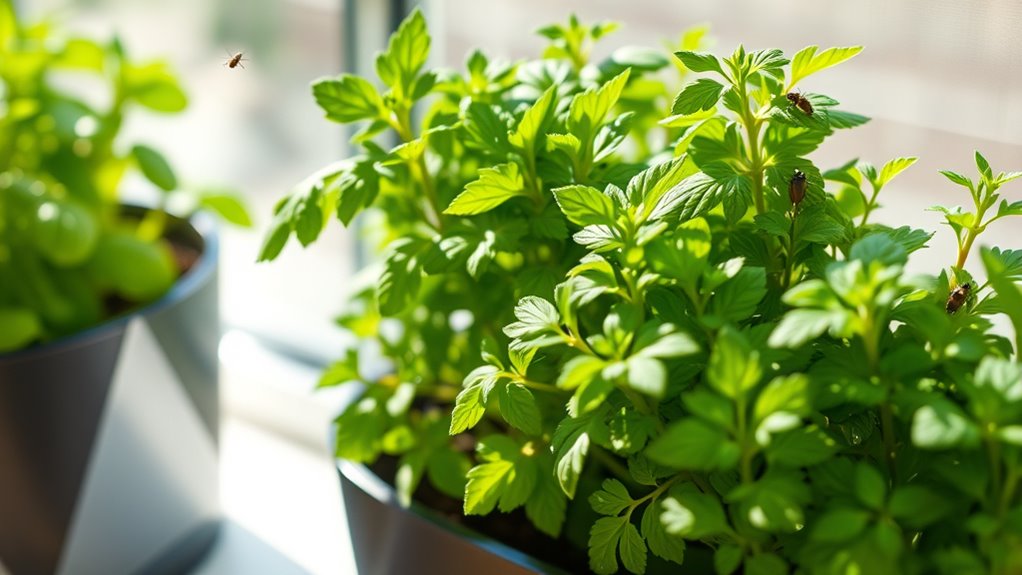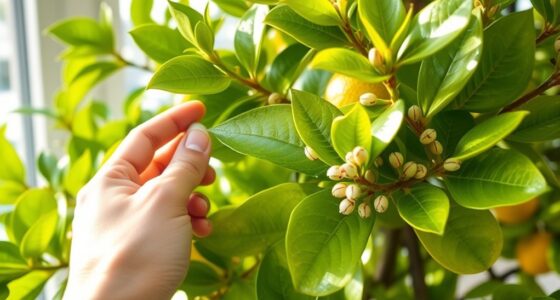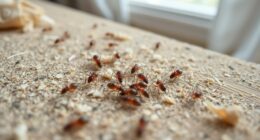To prevent whiteflies in your indoor herb garden, choose pest-resistant varieties and keep your plants healthy with proper pruning and cleanliness. Regularly inspect leaves for early signs and use sticky traps to catch them early. Improve airflow with fans, control humidity, and introduce natural predators like ladybugs. Cover your herbs with fine mesh barriers and avoid overwatering or excess fertilizer. For detailed tips, discover how to create a pest-free oasis that thrives naturally.
Key Takeaways
- Use pest-resistant herb varieties and maintain proper plant hygiene to deter whiteflies naturally.
- Regularly inspect plants with magnifying tools and place sticky traps for early detection.
- Promote good airflow and control humidity with fans and vents to make conditions less attractive to whiteflies.
- Introduce beneficial insects like ladybugs or parasitic wasps for biological whitefly control.
- Install fine mesh covers or physical barriers to prevent whitefly access and reduce infestation risks.
Choose Resistant Herb Varieties
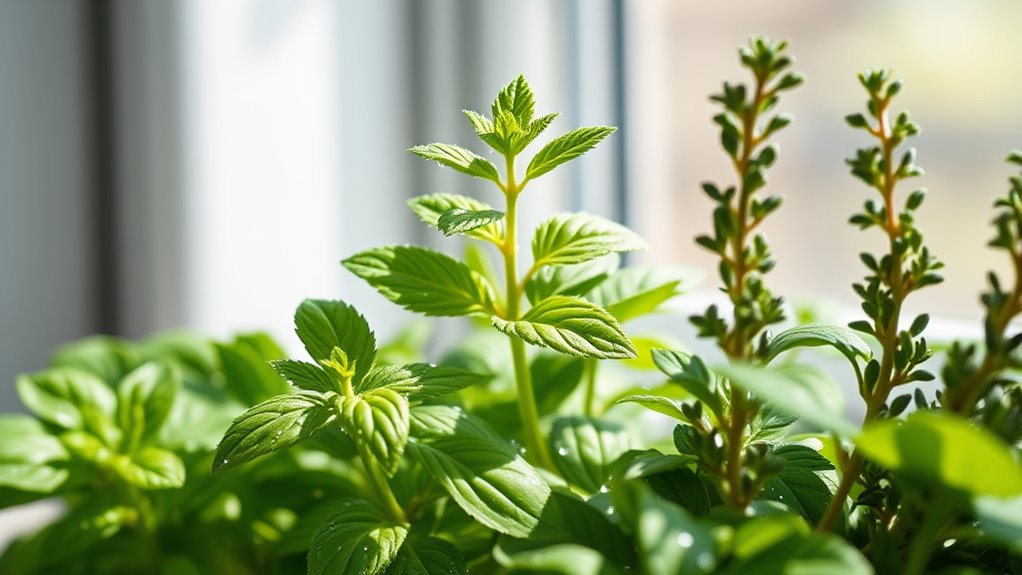
When selecting herbs for your indoor garden, opting for resistant varieties can markedly reduce whitefly problems. Resistant varieties are specially bred or naturally less appealing to pests like whiteflies, making herb selection easier and more effective. Look for herbs known for their pest resistance, such as certain types of basil, mint, and oregano. These varieties often have stronger aromas or tougher leaves that deter whiteflies. By choosing resistant herb varieties, you minimize the need for chemical treatments and create a healthier environment for your plants. Incorporating resistant options into your herb selection strategy is a proactive step that helps keep whiteflies at bay, ensuring your indoor garden stays lush and pest-free with less maintenance.
Inspect Plants Regularly for Early Signs
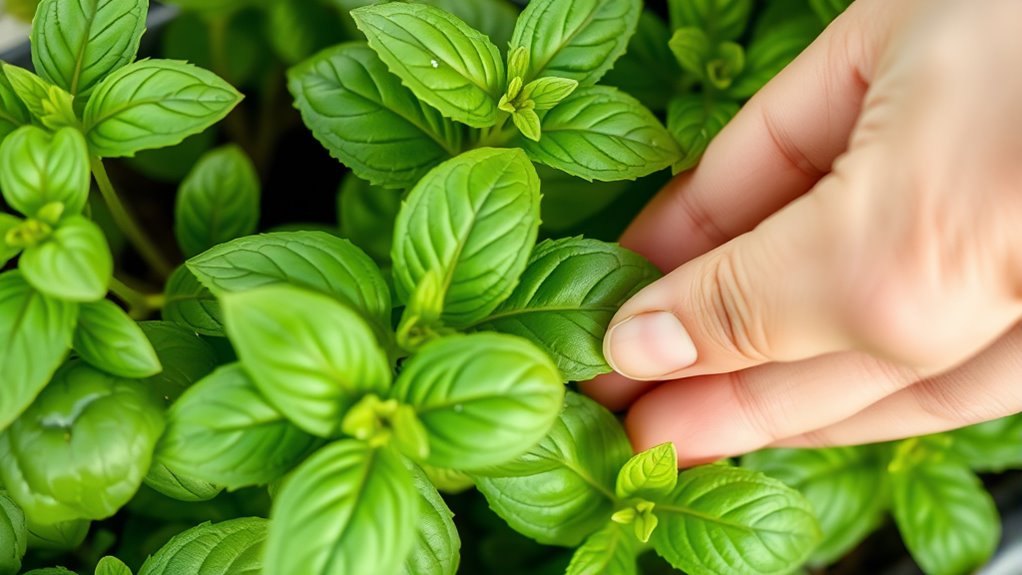
You should inspect your plants regularly to catch whiteflies early. Use a magnifying glass to spot tiny insects or eggs on the undersides of leaves. Recognizing signs like sticky residue or yellowing leaves helps you act before an infestation worsens. Paying attention to plant health indicators can further help identify early pest problems.
Visual Inspection Techniques
Regularly inspecting your indoor herb plants is essential for catching whiteflies early before they cause significant damage. Use a systematic approach by examining leaves and stems closely, paying attention to color contrast and light angles. Good lighting enhances visibility, making it easier to spot tiny pests. Adjust your light sources to highlight the undersides of leaves where whiteflies often hide. Use the following table to refine your inspection technique:
| Area to Inspect | Best Time for Inspection | Tips for Detection |
|---|---|---|
| Leaf undersides | Morning or evening | Use a flashlight for better view |
| New growth | Weekly | Look for sticky residue |
| Whole plant | Regularly | Check for yellowing or wilting |
Consistent, strategic inspections help you identify whiteflies early and protect your herbs effectively. Incorporating essential oils for plant health into your pest management routine may provide additional natural support in deterring whiteflies.
Recognizing Whitefly Signs
Early detection of whiteflies hinges on recognizing their telltale signs on your plants. Whitefly behavior includes swift movement when disturbed and persistent hovering around new growth. Look for plant stress symptoms such as yellowing leaves, wilting, or stunted growth, which often indicate pest issues. Regularly inspecting your herbs is key to catching problems early. Keep an eye out for:
- Tiny, white, moth-like insects on the undersides of leaves
- Sticky residue or honeydew on plant surfaces
- White, cottony specks that may be eggs or shed skins
- Yellowing or mottled leaf patterns
- Excessive leaf drop or slowed growth
- Incorporating integrated pest management techniques can help prevent infestations before they become severe.
Maintain Proper Air Circulation and Humidity

Maintaining proper air circulation and humidity levels is essential for preventing whiteflies in your indoor herb garden. Good ventilation enhancements ensure air flows evenly around your plants, reducing stagnant spots where pests thrive. Use fans or open vents to improve airflow, especially in tight spaces. Controlling humidity through proper humidity regulation keeps the environment less attractive to whiteflies, which prefer humid, stagnant conditions. Avoid overly moist air, as high humidity can encourage fungal issues and whitefly infestations. Keep your herbs spaced appropriately to promote airflow and prevent overcrowding. Regularly monitor humidity levels with a hygrometer, adjusting as needed. By maintaining ideal air circulation and humidity, you create an environment that’s less hospitable to whiteflies, helping keep your indoor herb garden healthy. Additionally, understanding contrast ratio can aid in evaluating the overall health of your garden’s environment, ensuring optimal conditions for your herbs to thrive.
Use Natural Predators and Biological Controls
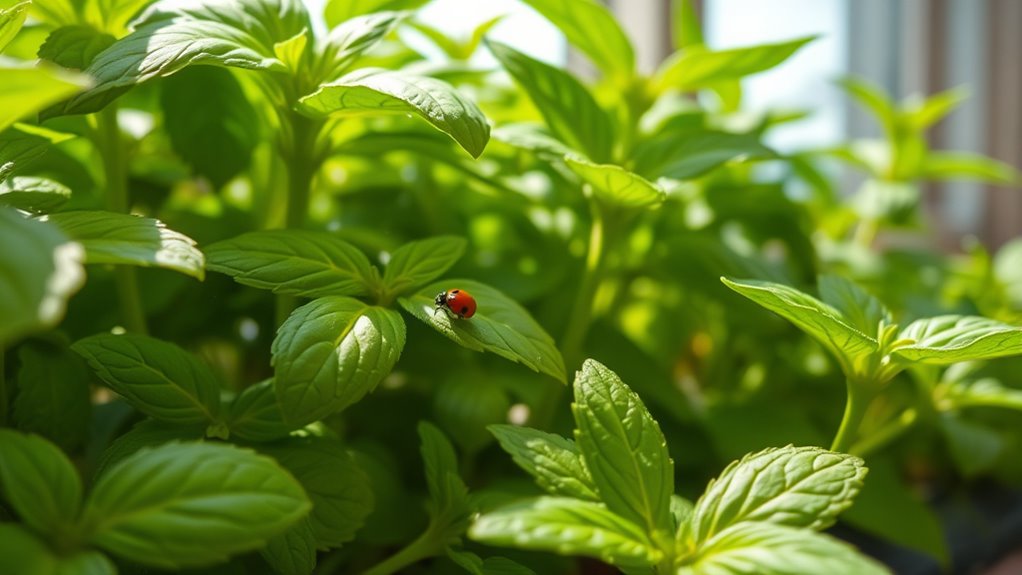
Introducing natural predators and biological controls can substantially reduce whitefly populations without relying on chemical pesticides. By using natural predator introduction, you target whiteflies directly, keeping your herb garden safe and eco-friendly. Biological control methods involve releasing beneficial insects that feed on whiteflies, such as ladybugs or parasitic wasps. Here are some effective options:
- Release ladybugs that feast on whiteflies
- Introduce parasitic wasps to lay eggs inside whitefly nymphs
- Use predatory mites to control immature whiteflies
- Employ nematodes for soil-dwelling whitefly stages
- Combine multiple biological control methods for maximum effect
These strategies help maintain a balanced ecosystem, reduce pest numbers, and promote healthy herb growth while keeping your indoor garden chemical-free. Biological control offers a sustainable approach to managing pests naturally.
Implement Gentle Cleaning and Pruning Practices

Regularly cleaning your herb garden and carefully pruning affected leaves can substantially reduce whitefly populations. Use gentle trimming to remove infested or damaged foliage without stressing your plants. When cleaning, employ careful wiping with a damp cloth or soft sponge to remove whiteflies and their eggs from leaves and stems. This method prevents the pests from spreading and minimizes plant damage. Avoid harsh chemicals or aggressive pruning that might harm your herbs. Consistent maintenance keeps your plants healthy and less attractive to pests. Focus on gentle trimming to maintain plant shape and health, and use careful wiping to clean surfaces thoroughly. Incorporating proper pest management techniques can further enhance your efforts to keep your indoor herb garden pest-free naturally. These practices create an inhospitable environment for whiteflies, helping you keep your indoor herb garden pest-free naturally.
Avoid Overwatering and Excess Fertilization
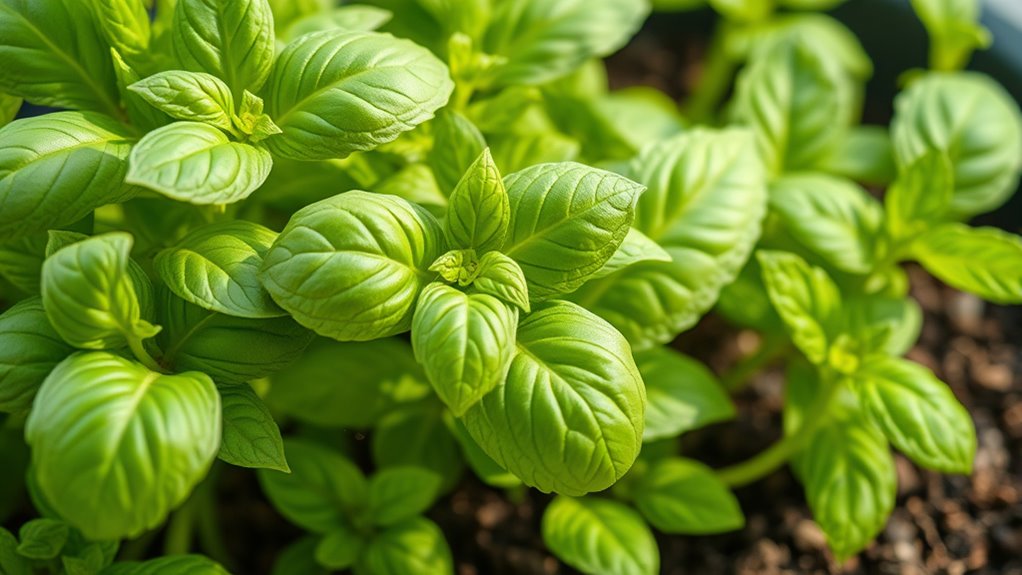
Overwatering and excess fertilization can create ideal conditions for whiteflies to thrive. When you overwater, roots become waterlogged, harming root health and making plants more vulnerable to pests. Excess fertilization throws off the nutrient balance, leading to weak, stressed plants that attract pests. To prevent this, consider these tips:
- Water only when the top inch of soil feels dry
- Use well-draining soil to avoid waterlogging
- Follow recommended fertilization schedules
- Avoid overfeeding with high-nitrogen fertilizers
- Monitor plant health regularly for signs of overwatering or nutrient imbalance
- Incorporate natural pest prevention methods such as companion planting or introducing beneficial insects to help keep pests like whiteflies at bay.
Create Barriers to Prevent Whitefly Entry

Creating physical barriers can substantially reduce the chances of whiteflies entering your indoor herb garden. Sticky barriers are an effective tool; place yellow or blue sticky traps near plants to catch flying pests before they settle. Mesh covers are another excellent option—cover your herbs with fine mesh screens to prevent whiteflies from gaining access while still allowing airflow and light. Confirm the mesh is tightly secured around pots and containers to eliminate gaps. Regularly inspect and replace sticky traps to maintain their effectiveness. These barriers act as a first line of defense, reducing pest populations without chemicals. Additionally, understanding celebrity lifestyle insights can inspire creative ways to maintain a healthy indoor environment. By combining sticky barriers and mesh covers, you create a physical shield that keeps whiteflies out and protects your herbs naturally.
Frequently Asked Questions
Can Whiteflies Survive in Soil or Only on Plant Surfaces?
Whiteflies primarily survive on plant surfaces, feeding on sap and laying eggs there. They rarely establish soil infestations, so your main concern is plant surface infestation. If you notice whiteflies, check your herbs closely, especially undersides of leaves. You can control them with insecticidal soap or neem oil. Regularly inspecting and cleaning your plants helps prevent a whitefly problem from spreading or becoming an infestation.
Are There Specific Indoor Conditions That Attract Whiteflies?
Whiteflies are attracted to indoor conditions with high humidity and bright, consistent lighting. You might notice they thrive in areas where air circulation is limited, and moisture levels are elevated. To reduce their attraction, keep humidity levels moderate, guarantee good airflow, and avoid overwatering your herbs. Adjusting your lighting to avoid overly intense or prolonged exposure can also help discourage whitefly presence.
How Long Does It Take to See Results After Implementing Control Methods?
About 7 to 10 days after you start control methods, you should notice visible signs of improvement. Typically, the timeframe expectations for seeing results depend on the severity of the infestation and the methods you use. An interesting statistic is that whiteflies can complete their life cycle in just 16 days, so consistent application of control measures is key. Stay patient and monitor your herbs closely for the best results.
Can Whiteflies Develop Resistance to Natural Predators?
Whitefly resistance can develop over time, reducing predator effectiveness. If you rely solely on natural predators, they might adapt and become less effective, making whiteflies harder to control. To avoid this, you should rotate predator species and combine them with other control methods. This integrated approach helps maintain predator effectiveness and prevents whitefly resistance, ensuring your indoor herb garden stays healthy and pest-free.
Are Any Herb Plants More Prone to Whitefly Infestations Than Others?
Like a magnet attracting metal, certain herbs show higher susceptibility to whiteflies. You’ll notice herbs such as basil, mint, and oregano often have more Whitefly preferences, making them more prone to infestations. These plants may emit scents or have leaf textures that attract whiteflies more than others. Understanding herb susceptibility helps you focus your pest control efforts effectively, keeping your indoor garden healthy and thriving.
Conclusion
By following these tips, you can keep whiteflies at bay and enjoy a thriving indoor herb garden. Did you know that whiteflies can reproduce up to 12 times in just a month, making early prevention vital? Regular inspection and natural controls are your best defenses. Stay vigilant, maintain good plant care habits, and create barriers to protect your herbs. With these strategies, you’ll enjoy fresh, pest-free herbs all year round.
